This is one in a series of posts on the Fujifilm GFX 100S. You should be able to find all the posts about that camera in the Category List on the right sidebar, below the Articles widget. There’s a drop-down menu there that you can use to get to all the posts in this series; just look for “GFX 100S”.
With the GFX 50S, GFX 50R, and GFX 100, I had experienced outdoor focus bracketing sequences where the camera ended the series before it was focused all the way to infinity. I’ve written that use of the feature off and not used it, but I never performed any testing aimed at finding a smoking gun. Several people have claimed that the focus bracketing does go all the way to infinity, and even beyond sometimes.
You know me, I had to test.
The protocol:
- RRS carbon fiber legs
- C1 head
- Tree at 100 meters, background behind it a several miles (I had to make sure to do this early in the morning before the thermal effects messed up the distant parts of the scene)
- ISO 100
- Electronic shutter
- 2-second self timer
- 80 mm f/1.7 lens
- f/1.7
- 1/2500 seconds
- With TC and without
- Focus bracketing with a step size of 2, number of steps 30 (and making sure it stopped before 30)
- Develop in Lightroom 10.2
- Sharpening amount 20, radius 1, detail 25
- Daylight white balance
The scene:
I focused well in front of the central tree, and picked a high number of exposures so that the camera would try to focus all the way to what it thought was infinity. Then I manually focused on the houses behind the tree and made an exposure. I repeated that three times, and all the manually focused images were about the same.
Here are the last 6 frames of the focus-bracketed series in the same order as the camera shot them, at a bit over 200% magnification.
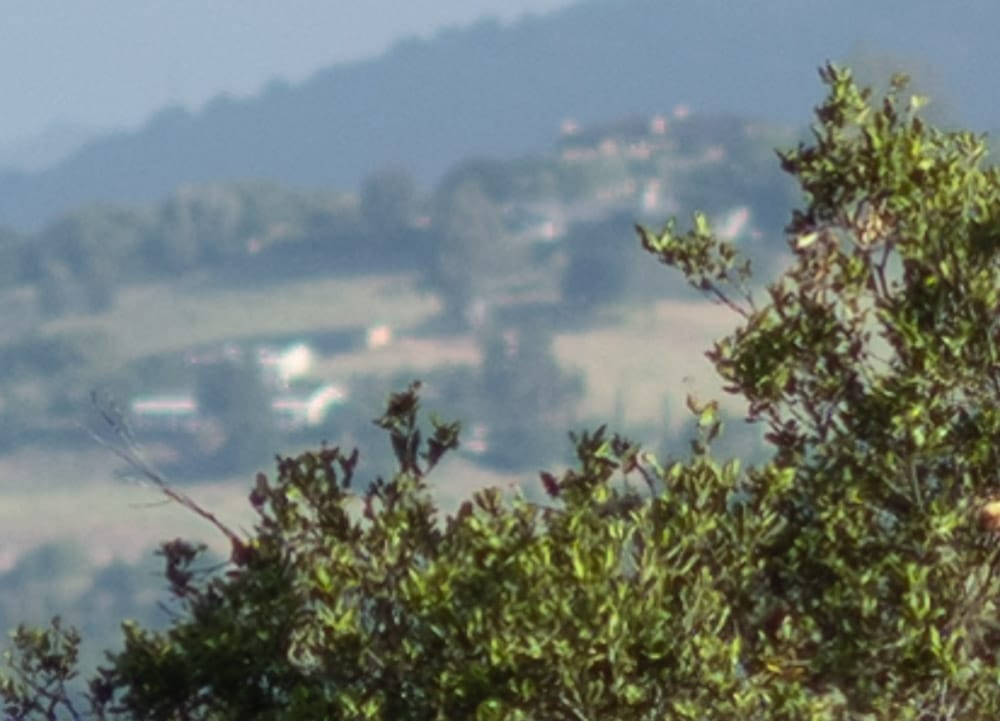
Focus is in front of the tree.
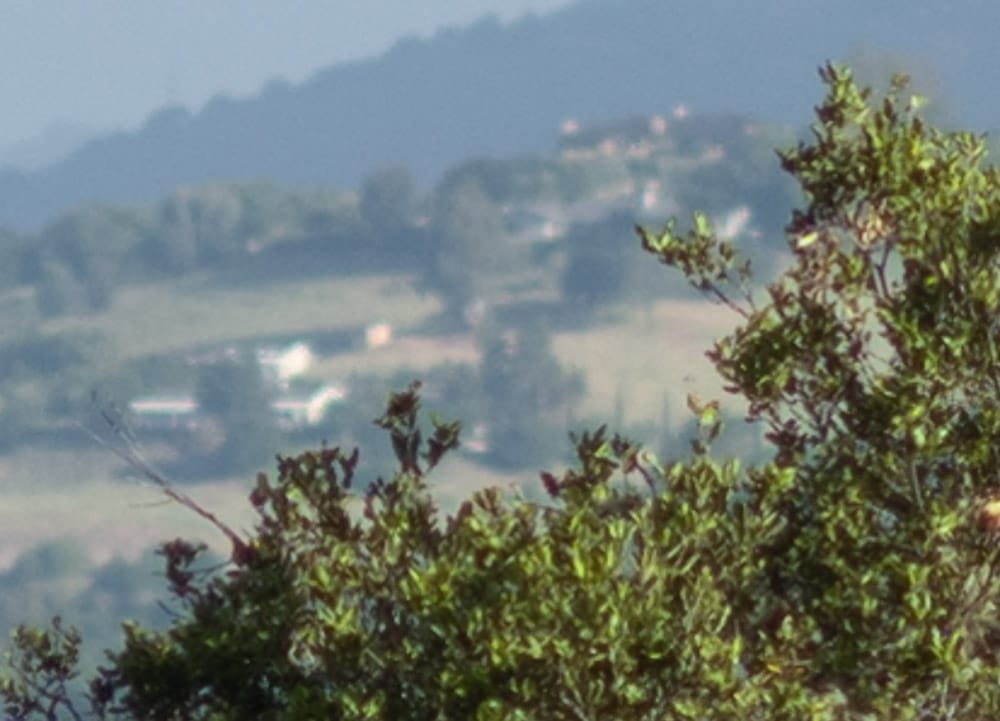
Focus is on the tree.
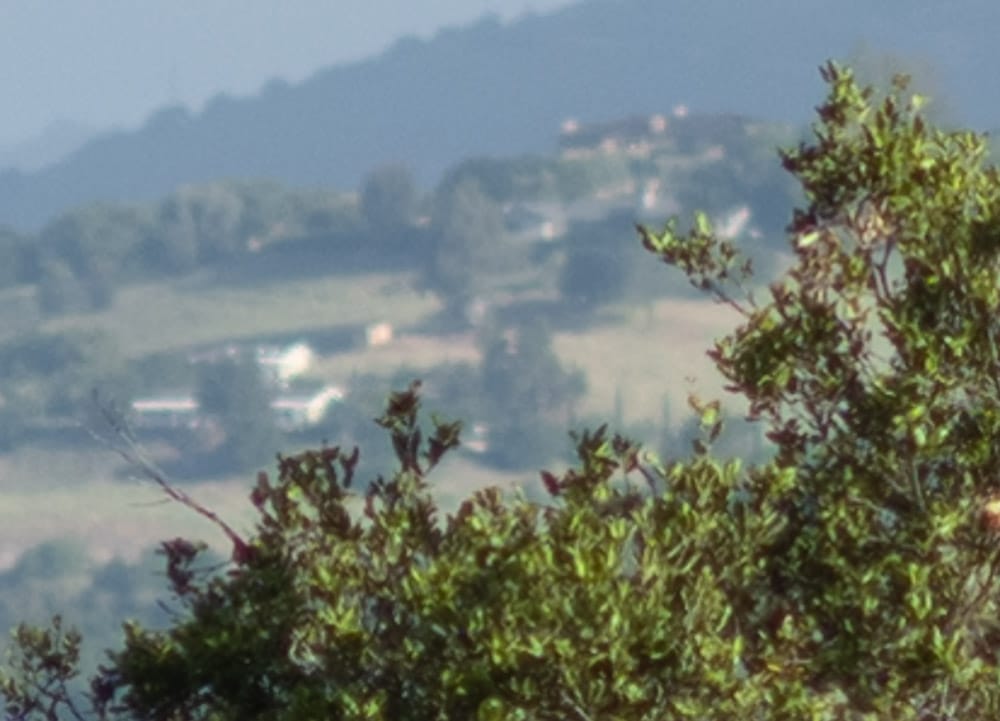
Focus is slightly behind the tree.
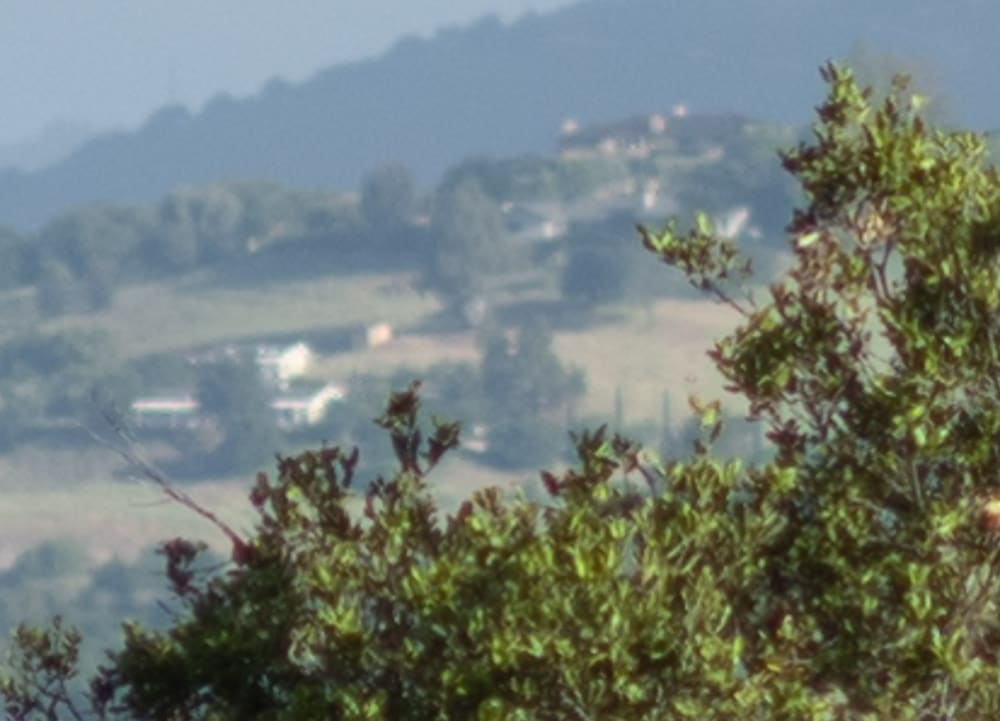
Focus is more behind the tree.
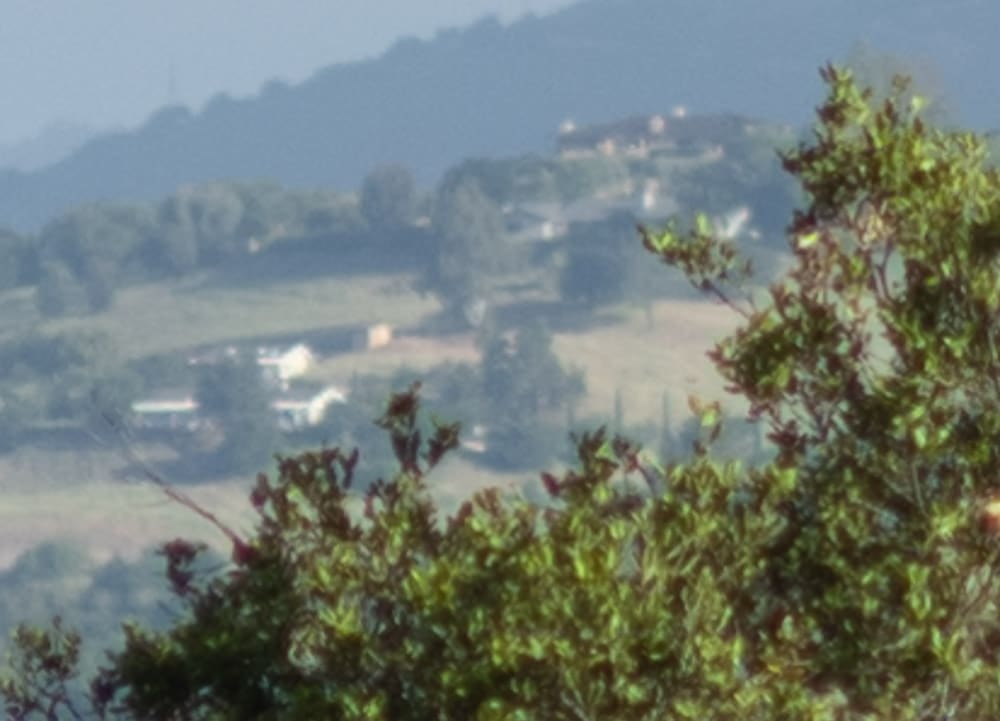
Focus is still more behind the tree.
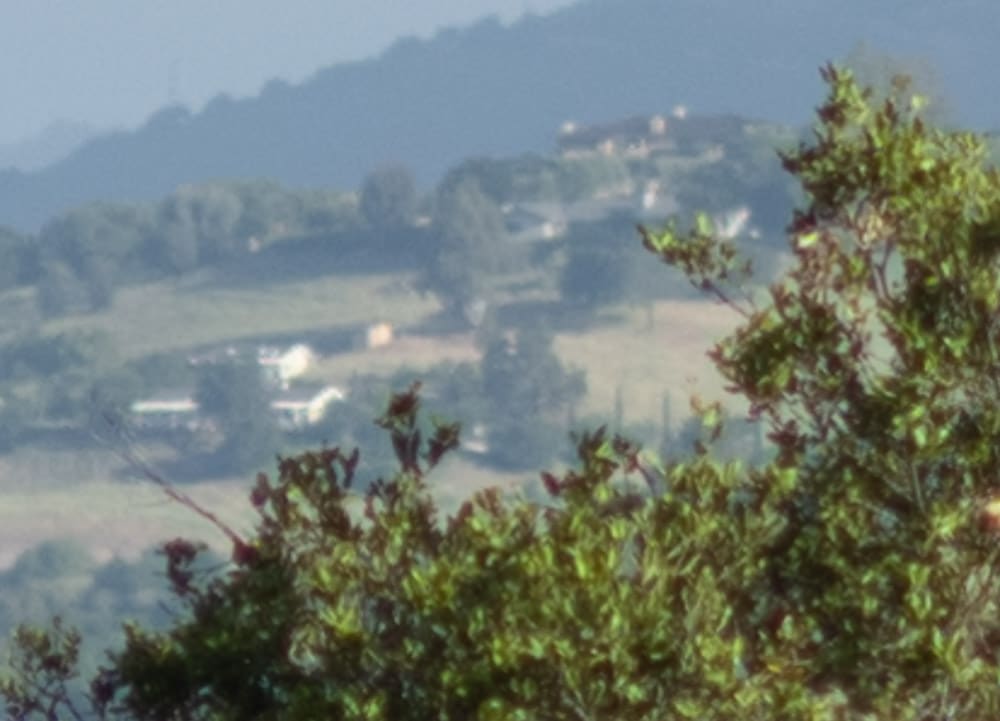
Focus is more behind the tree, but not on the houses.
Here’s a manually-focused image:
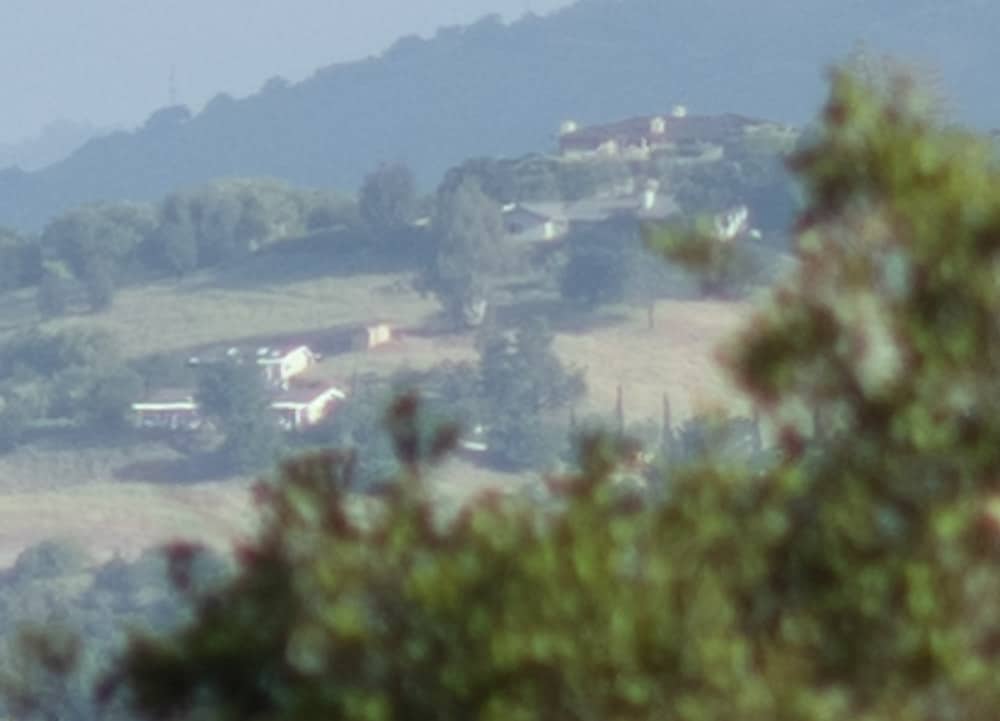
You can see that the houses are much sharper, and the tree is much blurrier, than the last focus bracketed frame.
This is the smoking gun.
When I tried this experiment with shorter, slower lenses, I got the same results, but because of the increased depth of field, the differences were far less dramatic. Admittedly, this is not a realistic use of focus bracketing, but it does bear out what I’ve observed before.
I think Fujifilm should modify their firmware to allow focus bracketing to go slightly past what the camera thinks is infinity. You can manually focus past infinity, so it’s not a hardware issue.
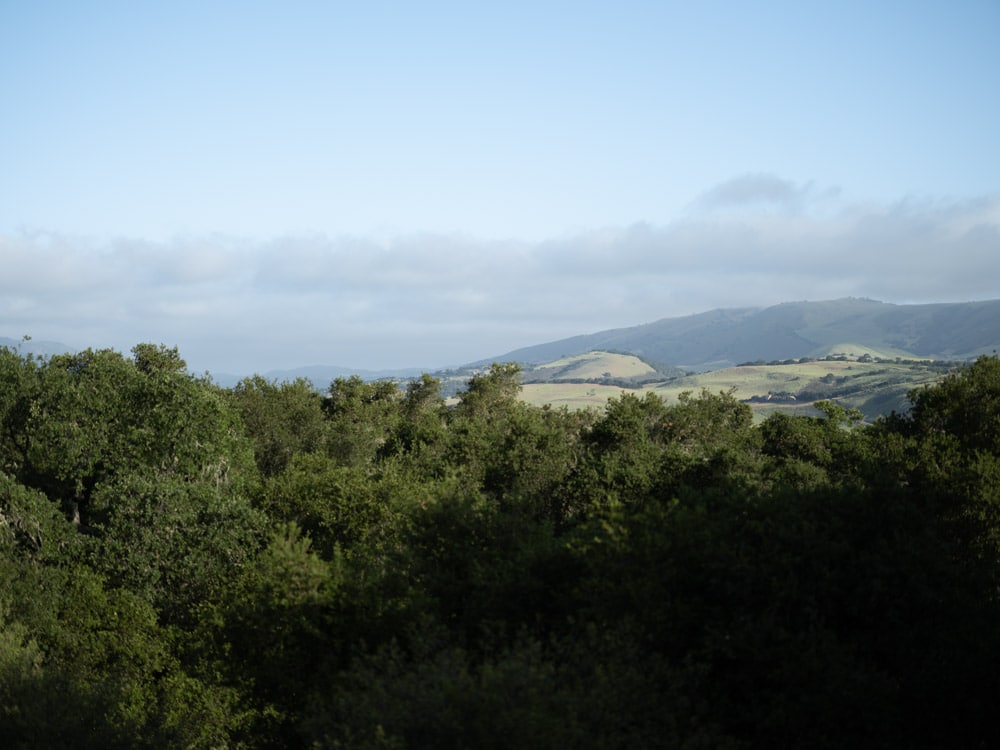
which lens did you use?
It’s in the protocol. 80/1.7.
Nice test Jim. It would be very nice indeed if Fuji would make one frame be exactly at infinity but also to make another frame be one step beyond infinity, because we’re talking about on-axis focus here and curvature so often makes the corners or shorter radius regions focus closer. For example with all four copies of the 32-64 that I’ve studied, at 32mm the corners focus pretty close to the same distance as the middle but a large ring closer in to the axis focuses significantly closer. At 45 and 64 mm that big donut of closer focus is expanded so the corners and a substantial area in from the corners focus too close. This, in turn, means that, even if we’re resorting to using the “Focus Bkt”feature to assure complete in-focus results for a typical landscape scene with infinity included, we still have to stop down enough that half (or as you have shown, less than half) of the DOF at the chosen aperture has to extend far enough distant to fully capture the most distant parts of the scene in the focusing-too-close part of the lens’s field. My observations of the system at this point suggest that one might need to stick to using ~f/11 or smaller for a focus bracket with the 32-64 to assure decent focus near infinity over the entire frame at any focal length (because of this limitation), though 45 and 64mm do require more stopping down than 32mm. I personally would prefer to use f/11 or smaller anyway, in many cases at least, to minimize the number of frames needed and the number of seams between frames, where moving vegetation is likely to cause problems, as well as to avoid requiring such a large amount of data to be involved in the solution.
There’s another thing: If Fuji’s calculation for the sequence of distances is done by starting at precisely the near distance chosen by us (seems likely) and the step size in diopters is calculated by the user’s choice of step size at a given aperture and focal length, then we would not expect the last step to fall, by chance, at infinity. Then again, your series results do seem to show that it stopped at least one, seemingly more steps shy of the end. I prefer a step size of 10 so far, finding there to be plenty of overlap still in the zone of good focus, and with such a much larger focus step size it’s easy to imagine their last calculated focusing distance being well short of infinity.
We could try a test at step size 5 or larger and somewhat stopped down where we start series at say 20 feet, 30 feet and 45 feet, something like that (or maybe 7, 8, 9 and 10feet), and see how much the apparent last frame focusing distance varies (might not be discernible in the results though).
Fuji could also respond to these observations by simply adding one more frame to every sequence, because they figure the last frame has been aimed at something less than infinity because that’s how they planned it all along. I.e. by their calculation working the way I described it above. If not also by accepting the fact of forward field curvature. I’ll bet that’s what’s going on and how they will respond. It should be a solid solution. Just add one more step. But then again there’s the error in the lens’s reported on-axis focusing distance too to contend with. So maybe all things considered with tiny step sizes like 2 they should be adding 2 or 3 or 4 additional exposures. So there would be a progression in the number of added exposures increasing from 1 extra at step size 10 to 3 or 4 extras for step sizes 1 and 2.
Also: have you noticed how often the Focus Bkt series result in an odd number of captures? I think maybe I got an even number once but maybe not. That suggests that they are allowing their calculated step size to be modified in response to at least one concern. For example if we do get, say 7 frames in a sequence, it’s nice to be able to then choose to leave out every other one and still keep the nearest and farthest frames. So maybe as soon as they figure 5 steps is no longer enough they jump up to 7, with a commensurate shrinking of the step size. In any case we do need more on the far side.
The other possibility is to allow focus bracketing to start at the far point, e.g., infinity.
You can do that with the X1D-II.
I’ve had exactly that problem, Jim, and it cost me what was potentially a gorgeous image – I was disappointed!
Wouldn’t FOCUS BKT -AUTO solve this problem (the user can choose infinity as the ending point of focus)?
Doesn’t work.
That’s been my experience. Works perfectly in auto using the 120mm Macro